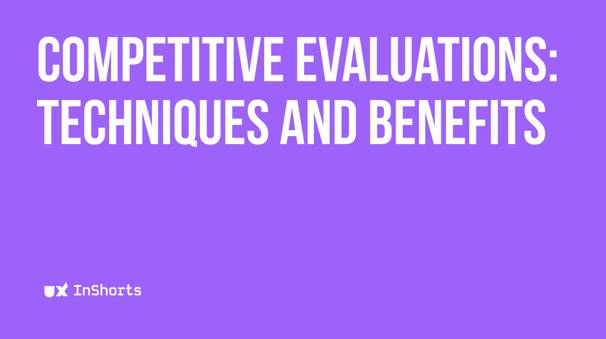Competitive Evaluations: Techniques and Benefits
Competitive evaluation is a valuable research method for comparing your company's products or services with those of competitors. This process assesses the strengths and weaknesses of competitors, offering insights into how others tackle similar design challenges.
BLOGUX DESIGN
8/2/20242 min read


Introduction
Competitive evaluation is a valuable research method for comparing your company's products or services with those of competitors. This process assesses the strengths and weaknesses of competitors, offering insights into how others tackle similar design challenges.
Methods of Competitive Evaluations
There are two primary methods for conducting competitive evaluations: Competitive Reviews and Competitive User Research.
Competitive Reviews
Expert Review: Involves experienced usability practitioners evaluating multiple competing designs based on specific criteria and established usability principles.
Advantages: Time-efficient, no need for a detailed research plan, participants, or dedicated research time.
Disadvantages: May result in biased outcomes without user data, and can perpetuate unfounded assumptions.
Usage: Ideal as a starting point for more focused research, especially for those new to UX or lacking initial user data.
Competitive User Research
Competitive Usability Testing: Researchers observe users completing realistic tasks on various competing designs.
Advantages: More objective, produces tangible user data, especially valuable when initial data or experience is lacking.
Disadvantages: Requires more time for planning, recruiting participants, conducting studies, and analyzing data.
Usage: Best to focus on two to four prioritized competing designs to avoid overly complex study plans.
Optimal Timing for Competitive Evaluations
Competitive evaluations can be beneficial at any stage of product development but are most effective early on as a foundation for further research and design efforts. They are also useful when there are no direct rivals, helping to identify alternative solutions to user needs.
Example Scenario
Imagine a world where ride-sharing apps like Uber or Lyft don't exist. Competing solutions would include taxis, car rental companies, and even friends offering rides. Understanding these alternatives is crucial for designing a new solution or enhancing an existing one.
Best Practices for Competitive Evaluations
Understand the Market: Gain a comprehensive understanding of the competitive landscape and available user solutions.
Innovate Beyond Competitors: Look for opportunities to innovate rather than simply mimicking competitors.
Prioritize User Needs: Focus on user experience and effectively address their needs.
Continuous Improvement: Treat competitive evaluations as an ongoing process to refine and enhance designs.
Conclusion
Competitive evaluations help organizations understand their market position and identify areas for improvement. Whether you're launching a new product or refining an existing one, knowing the competitive landscape is crucial for success.
UX Inshorts was born out of a passion for making UX knowledge accessible and engaging. We understand that in the fast-paced world of design, staying updated with the latest trends, tools, and best practices can be challenging. That's why we focus on delivering bite-sized content that fits seamlessly into your busy schedule.
Quick Links
Subscribe to UX Inshorts
Follow Us
